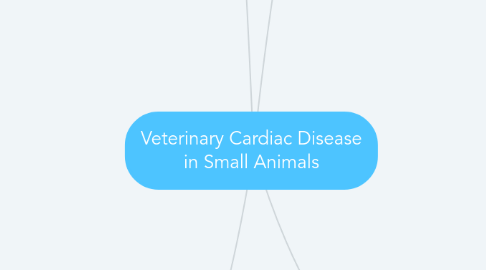
1. Cat Cardiovascular disease
1.1. Cardiomyopathies
1.1.1. Hypertrophic cardiomyopathy - LV Most common
1.1.1.1. From Hypertension, acromegaly, hyperthyroidism - mutations in contractile proteins and sarcomeres
1.1.1.1.1. LV doesn't relax, stiff ventricle, diastolic dysfunction, poor myocardial perfusion - pulmonary oedema, intra-cardiac thrombus, arrythmias
1.1.1.1.2. Inc. RR, effort, oedema, pleural effusion Thromboembolism - terminal aorta, sudden paralysis, painful, distressed, saddle thrombus Sudden death - ventricular tachy then fibrillation
1.1.1.2. Genetic? - Maine coons, Ragdolls
1.1.1.3. Variable intensity murmur, apical impulse, gallop, arrythmias, tachypnoea, crackle, may seem normal
1.1.1.3.1. Echo - big LA yet or no?
1.1.1.3.2. Cardiac Troponin-I NT - proBNP - SNAP test
1.1.1.3.3. Rule out hyperthyroidism
1.1.1.3.4. Treatment
1.1.2. Dynamic Left ventricle outflow tract (Systolic Anterior Motion of mitral leaflet, SAM) - mitral valve regurge
1.1.2.1. Any age, more prevalence in older Maine coon, PErsian, Ragdoll, Cornish rex, Bengal
1.2. Congenital disease
1.3. Arrythmias
2. Young Animal with Murmur
2.1. Flow murmurs
2.1.1. High CO, reduced blood viscosity
2.2. Significant murmurs usually signify presence of congenital heart disease - highest incidence in dogs
2.2.1. Valvular malformations (dysplasia) - stenosis/insufficiency
2.2.1.1. Mitral and/or tricuspid dysplasia
2.2.1.1.1. Stenosis and/or insufficiency of valve, volume load on left or right
2.2.2. Foetal vessel - Patent Ductus Arteriosus
2.2.2.1. Continuous murmur, L base
2.2.2.2. L to R shunt (unless pulmonary hypertension bounding pulses
2.2.2.2.1. Volume loaded LHS and pulmonary circulation - can see with Doppler
2.2.2.2.2. Radiography - three knuckles, Ao PA LA
2.2.2.2.3. Systemic compensation - even more blood through to pulmonary circulation, overload LA and LV
2.2.2.2.4. Treatment
2.2.3. Vasculature malformation - vascular ring anomaly
2.2.3.1. Increased resistance/stenosis to ejection causes pressure overloads
2.2.3.2. Aortic stenosis
2.2.3.2.1. Pressure overload VS, left base systolic murmur, poor pulse
2.2.3.3. Pulmonic stenosis
2.2.3.3.1. RV overload pressure, left base systolic murmur, pulse less affected?
2.2.4. Septal defects
2.2.4.1. Ventricular septum - systolic murmur, diagonal radiation, audiable on R thoracic wall
2.2.4.1.1. Stenosis of pulmonary valve, volume overloaded left side, pulmonary circulation
2.2.4.2. Inc load where the shunt goes
2.2.4.2.1. Heart compensation via systemic load - inc load through valve = stenosis = murmur
2.2.4.3. Atrial septal defect
2.2.4.3.1. L to R shunt, often not significant Normal on PE, soft murmur over pulmonic valve, relative pulmonic stenosis
2.2.5. Complex defects
2.2.6. May be incidental, or cyanosis, syncope, stunting, congestive failure, hepatic encephalopathy (Porto systm shunt), or regurgitation (Vasc ring anomaly)
2.2.6.1. Cyanosis - R to L shunting?
2.2.6.2. Exaggerated pulse - PDA? Poor pulse - aortic stenosis?
3. Canine Cardiovascular disease
3.1. Degenerative (acquired) mitral valve disease
3.1.1. Inc ventricular stroke volume, worsened by vasoconstriction
3.1.1.1. Endocardiosis
3.1.1.2. Myxomatous valve disease
3.1.1.3. Older dogs, small breeds (CKCS, Terriers, Poodles, Dachsund, Chihuahua), males earlier
3.1.1.3.1. Progressive LCHF (cough, dyspnoea, exercise intolerance), collapse (Dysrhythmias), sudden death rare (Arrythmia, left atrial tear, ruptured chord), RCHF later on
3.1.1.4. ECG normal until later Radiography, Echo
3.1.1.4.1. Doppler echo - definitive diagnosis
3.2. Cardiomyopathy
3.2.1. Dilated cardiomyopathy - common in dogs (Boxers, Dobermans)
3.2.1.1. Systolic failure Dilated ventricle - insufficient valve secondary
3.2.1.2. May be incidental, forward failure, intermittent collapse, weak, sudden death Backward failure - cough, exercise intolerance, dyspnoea, ascites
3.2.1.2.1. Systolic murmur (50%), Gallop rhythm (diastole), arrythmia, pulse deficits, chronic heart failure signs (RHS)
3.2.1.2.2. ECG - variety of rhythm disturbances Radiography (cardiomegaly, congestive HF, RCHF) Echo (hypokinetic LV, low FS)
3.2.2. Hypertrophic - common in cats
3.2.3. Restrictive
3.2.4. Arrythmogenic RV cardiomyopathy
3.2.5. Intermediate/Unclassified
3.3. Pericardial effusion
3.3.1. Neoplastic
3.3.1.1. RA haemangiosarcoma, chemodectoma, mesothelioma
3.3.2. Idiopathic
3.3.3. Common cause of RCHF in dogs
3.3.3.1. Inc venous pressure and congestive RCHF, acute, compromised diastolic function
3.3.3.1.1. Acute, lethargy, ascites, dyspnoea (pleural effusoin), collapse, coughing
3.3.3.1.2. RCHF (jugular pulse and distension, ascites, hepatomegaly) Fluid around heart (muffled, pulsus paradoxus - femoral with inspiration)
3.3.3.1.3. ECG (small QRS) Radiography (generalised enlargement), RCHF Ultrasound (fluid, cause for effusion, cardiac tamponade) or to aid pericardiocentesis
3.4. Bacterial endocarditis
3.4.1. Infection of endocardium, typically valvular
3.4.1.1. Pyrexia, lameness, sepsis
3.4.1.2. Echo, Blood culture, changing murmur
3.4.1.2.1. Appropriate antibiotic Guarded prognosis
4. Cardiovascular disease in Other species
4.1. Echo - only through soft tissue
4.1.1. Bird: trans-hepatic, sub costal view
4.1.2. High fq = good images of structures near transducer, not for imaging large structures High frame rate for fast HR
4.2. Cardiac disease
4.2.1. Therapeutics
4.2.1.1. Furosemide (small mammals, rabbits, ferrets) ACEI Anti-arrythmics Beta-blockers Pimobendan (rats, ferrets, rabbits)
